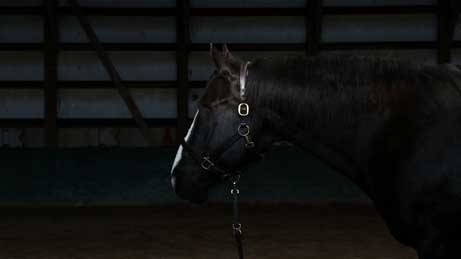Over the past decade or so, the American videomaker and sculptor Corey McCorkle has countered the dry analysis of contemporary neoconceptualism with work that leavens theory with poetic association. He has, for example, distilled dandelions into wine on a noble Irish estate and filmed feral dogs roaming an unfinished zoo in Istanbul; in the process, he probes how craft transforms dross into art and how culture stands as a bulwark against our own baser nature.
he probes how craft transforms dross into art
Consisting of two works, and remarkably spare even by the standards of his own glancing, metaphorical references, McCorkle’s most recent show offers a deep disquisition on habit, art and ethics. There is Crevice (both works 2013), a cut in the gallery walls the width of a folded sheet of paper that forms a line slightly above eye level. It admits light from the outside but never illuminates the otherwise dark space. Diagonally opposite it, a silent video, titled Monument, of a black horse, his eye sockets empty and matt, plays on a loop.
In place of a press release, McCorkle has left a copy of Georges Bataille’s monograph Lascaux ou la Naissance de l’Art (1955) on a counter in the gallery for viewers to consult as they wish (60 percent of the Palaeolithic paintings in the Lascaux caves in southern France depict equines).
Bataille wrote extensively on the unstable relationship between matter and mind, experience and image, and his book, also a nod to Plato’s cave, makes it clear that McCorkle’s subject is the genesis of art in the human need to represent and tame the natural world. Crevice, expanding the reference to Plato, indicates that images are but shadows of a greater truth – literally the world outside the gallery – while the work’s often sharp intensity suggests that faith in art, theory and craft blinds us to it.
McCorkle seems to suggest that it’s our limitations, or our ability to accept them, that can engender moral transcendence
The horse becomes an allegory both of the limits of sight and the possibility of values beyond our own needs. In his stall he feeds on hay, and bridled in a ring, he sways his head as if sensing the surroundings through vision recalled (his eyes were removed several years ago due to disease). He exists for his own sake, rather than for his usefulness to people.
As it’s the animal’s imperfection that renders him hauntingly beautiful – an avatar of ‘Horse’ rather than a horse; the type rather than its token – McCorkle seems to suggest that it’s our limitations, or our ability to accept them, that can engender moral transcendence. In writing on Lascaux, Bataille discusses a universal yet impossible goal of understanding these prehistoric artists through their paintings, as if the urge, rather than the image, is itself the foundation of culture. It’s all very heady and slightly spiritual, and McCorkle moots the ideas through deft and subtle associations and oppositions. But the work never coalesces to become a forceful example of aesthetic incandescence; rather, it remains a discussion of it.
This review originally appeared in the October 2013 issue.
